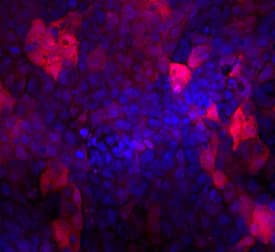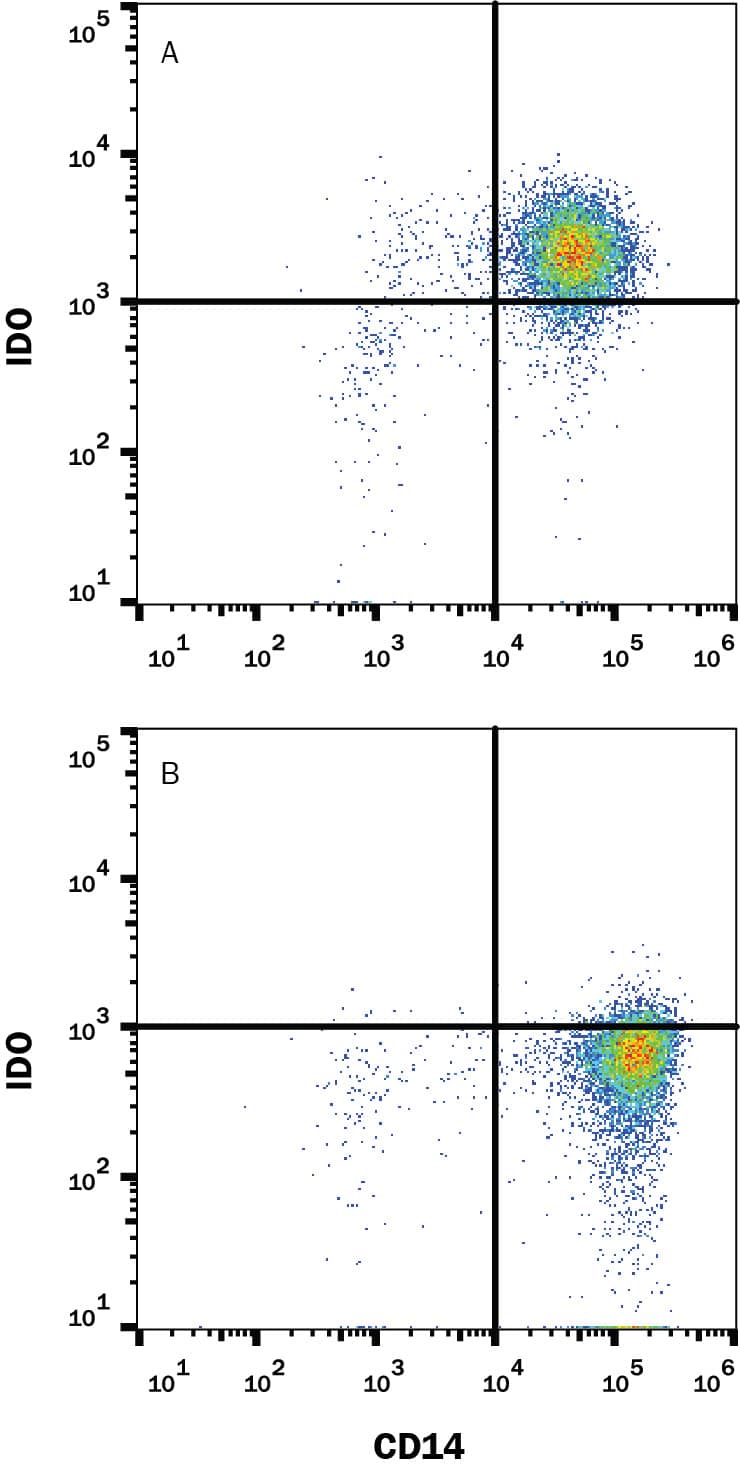Human Indoleamine 2,3-dioxygenase/IDO Antibody
R&D Systems, part of Bio-Techne | Catalog # MAB6030


Conjugate
Catalog #
Key Product Details
Validated by
Biological Validation
Species Reactivity
Validated:
Human
Cited:
Human
Applications
Validated:
CyTOF-ready, Immunocytochemistry, Intracellular Staining by Flow Cytometry
Cited:
Flow Cytometry, Immunohistochemistry, Western Blot
Label
Unconjugated
Antibody Source
Monoclonal Mouse IgG1 Clone # 700838
Product Specifications
Immunogen
E. coli-derived recombinant human Indoleamine 2,3-dioxygenase/IDO
Ala2-Gly403
Accession # P14902
Ala2-Gly403
Accession # P14902
Specificity
Detects human Indoleamine 2,3-dioxygenase/IDO in direct ELISA.
Clonality
Monoclonal
Host
Mouse
Isotype
IgG1
Scientific Data Images for Human Indoleamine 2,3-dioxygenase/IDO Antibody
Indoleamine 2,3-dioxygenase/IDO in A431 Human Cell Line.
Indoleamine 2,3-dioxygenase/IDO was detected in immersion fixed A431 human epithelial carcinoma cells stimulated with 0.5 ng/mL of Recombinant Human IFN-gamma (Catalog # 285-IF) using Mouse Anti-Human Indoleamine 2,3-dioxygenase/IDO Monoclonal Antibody (Catalog # MAB6030) at 10 µg/mL for 3 hours at room temperature. Cells were stained using the NorthernLights™ 557-conjugated Anti-Mouse IgG Secondary Antibody (red; Catalog # NL007) and counter-stained with DAPI (blue). Specific staining was localized to cytoplasm. View our protocol for Fluorescent ICC Staining of Cells on Coverslips.Detection of Indoleamine 2,3‑dioxygenase/IDO in Human MDSCs by Flow Cytometry.
Human PBMC-derived myeloid-derived suppressor cells (MDSCs) treated with 10 ng/mL Recombinant Human IL-6 (Catalog # 206-IL) and 10 ng/mL Recombinant Human GM-CSF (Catalog # 215-GM) for 7 days were stained with Mouse Anti-Human Siglec-3/CD33 APC-conjugated Monoclonal Antibody (Catalog # FAB1137A) and either (A) Mouse Anti-Human Indoleamine 2,3-dioxygenase/IDO Monoclonal Antibody (Catalog # MAB6030) or (B) Mouse IgG1Isotype Control (Catalog # MAB002) followed by Phycoerythrin-conjugated Anti-Mouse IgG Secondary Antibody (Catalog # F0102B). To facilitate intracellular staining, cells were fixed with paraformaldehyde and permeabilized with saponin. View our protocol for Staining Intracellular Molecules.Detection of Indoleamine 2,3‑dioxygenase/IDO in Human Monocytes by Flow Cytometry.
Human Monocytes were selected from PBMC using MagCellect Human CD14+ Cell Isolation Kit (Catalog # MAGH105) and cultured overnight with (A) 50 ng/mL Recombinant Human MCSF (Catalog # 216-MC), 50 ng/mL Recombinant Human IFNg (Catalog # 285-IF) and 50 ng/mL LPS, or (B) Recombinant Human MCSF alone. Cells were stained with Mouse Anti-Human Indoleamine 2,3-dioxygenase/IDO Monoclonal Antibody (Catalog # MAB6030) followed by APC-conjugated Anti-Mouse IgG Secondary Antibody (Catalog # F0101B) and Mouse Anti-Human CD14 PE-conjugated Monoclonal Antibody (Catalog # FAB3832P). Quadrant markers were set based on Mouse IgG1 Isotype Control (Catalog # MAB002). To facilitate intracellular staining, cells were fixed with 1% paraformaldehyde and permeabilized with saponin. View our protocol for Staining Intracellular Molecules.Applications for Human Indoleamine 2,3-dioxygenase/IDO Antibody
Application
Recommended Usage
CyTOF-ready
Ready to be labeled using established conjugation methods. No BSA or other carrier proteins that could interfere with conjugation.
Immunocytochemistry
8-25 µg/mL
Sample: Immersion fixed A431 human epithelial carcinoma cell line
Sample: Immersion fixed A431 human epithelial carcinoma cell line
Intracellular Staining by Flow Cytometry
2.5 µg/106 cells
Sample: Human myeloid-derived suppressor cells (MDSCs) treated with Recombinant Human IL‑6 (Catalog # 206-IL) and Recombinant Human GM‑CSF (Catalog # 215-GM), and Human Monocytes selected from PBMC using MagCellect Human CD14+ Cell Isolation Kit (Catalog # MAGH105) and cultured with Recombinant Human MCSF (Catalog # 216-MC), Recombinant Human IFNg (Catalog # 285-IF) and LPS, were fixed with paraformaldehyde and permeabilized with saponin
Sample: Human myeloid-derived suppressor cells (MDSCs) treated with Recombinant Human IL‑6 (Catalog # 206-IL) and Recombinant Human GM‑CSF (Catalog # 215-GM), and Human Monocytes selected from PBMC using MagCellect Human CD14+ Cell Isolation Kit (Catalog # MAGH105) and cultured with Recombinant Human MCSF (Catalog # 216-MC), Recombinant Human IFNg (Catalog # 285-IF) and LPS, were fixed with paraformaldehyde and permeabilized with saponin
Formulation, Preparation, and Storage
Purification
Protein A or G purified from hybridoma culture supernatant
Reconstitution
Sterile PBS to a final concentration of 0.5 mg/mL. For liquid material, refer to CoA for concentration.
Formulation
Lyophilized from a 0.2 μm filtered solution in PBS with Trehalose. *Small pack size (SP) is supplied either lyophilized or as a 0.2 µm filtered solution in PBS.
Shipping
Lyophilized product is shipped at ambient temperature. Liquid small pack size (-SP) is shipped with polar packs. Upon receipt, store immediately at the temperature recommended below.
Stability & Storage
Use a manual defrost freezer and avoid repeated freeze-thaw cycles.
- 12 months from date of receipt, -20 to -70 °C as supplied.
- 1 month, 2 to 8 °C under sterile conditions after reconstitution.
- 6 months, -20 to -70 °C under sterile conditions after reconstitution.
Background: Indoleamine 2,3-dioxygenase/IDO
References
- Lewis-Ballester, A. et al. (2009) Proc. Natl. Acad. Sci. USA. 106:17371.
- Costantino, G. (2009) Expert Opin. Ther. Targets 13:247.
- Xu, H. et al. (2008) Immunol. Lett. 121:1.
- Lob, S. et al. (2009) Nat. Rev. Cancer 9:445.
- Curti, A. et al. (2009) Blood 113:2394.
Alternate Names
3dioxygenase, IDO, IDO1, INDO, Indoleamine 2
Gene Symbol
IDO1
UniProt
Additional Indoleamine 2,3-dioxygenase/IDO Products
Product Documents for Human Indoleamine 2,3-dioxygenase/IDO Antibody
Product Specific Notices for Human Indoleamine 2,3-dioxygenase/IDO Antibody
For research use only
